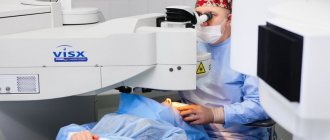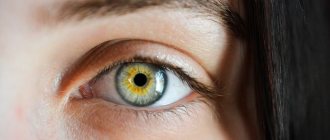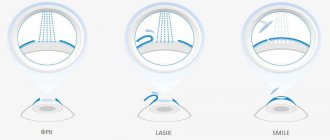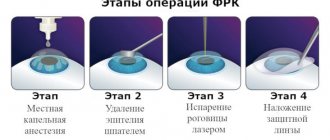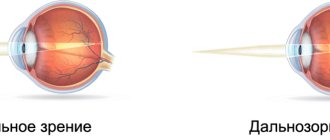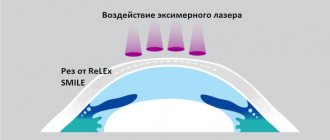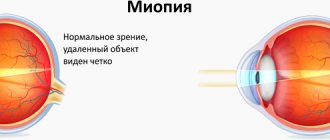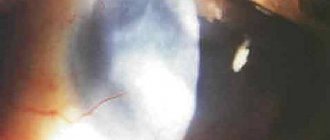LASIK is the most popular laser eye surgery. It is now carried out in approximately 50 countries. Every year, about 1 million LASIK operations are performed worldwide. In some countries, such as Japan and the USA, this procedure is available even in shopping centers. LASIK's popularity is due to its safety and effectiveness.
In this article
- What is LASIK surgery?
- Main indications for LASIK surgery
- Are there any restrictions to LASIK surgery?
- When is LASIK laser correction strictly prohibited?
- How is LASIK laser surgery performed?
- Stages of LASIK surgery
- How is recovery after LASIK surgery?
- What complications occur after LASIK surgery?
- What are the benefits of LASIK surgery?
What is LASIK surgery?
Not to say that LASIK is the latest technique developed in recent years. This method of correcting vision defects was created back in the 80s of the 20th century in the USA. The first LASIK surgery was successfully performed in 1987. Today it is more in demand because it has become available to almost everyone. LASIK is an acronym. The full name of the procedure is Laser Assisted in Situ Keratomileusis, or simply laser keratomileusis.
This method of vision restoration is carried out using a special excimer laser, which is capable of creating strong ultraviolet radiation that affects the cornea and corrects its shape. The procedure itself is very simple, does not require long preparation and helps to cure almost any visual pathology.
What methods exist?
Today, modern ophthalmology clinics perform two types of laser eye surgeries. The first technique is called LASIK. The name of this technology comes from the acronym LASIK (Laser-Assisted in Situ Keratomileusis), which in “medical language” means laser keratomileusis, that is, literally, separation of a flap of the cornea, entailing correction of its internal layers and then, upon completion of the operation, return flap to its original location. Indications for LASIK are:
- myopia no more than -15;
- farsightedness no more than +4;
- astigmatism from +3 to -3.
You can often find the terms Super LASIK or NASA LASIK used in medical journals or topical programs. As ophthalmologists say, this is still the same laser correction procedure, no different. According to their assumptions, such names were invented by employees of medical clinics who wanted to attract additional attention from patients.
Another technology that allows operations to be performed using a laser beam is PRK or photorefractive keratectomy. It involves removing the top layer of the cornea using an excimer laser. One of the most tangible benefits of PRK is the reduction in physical impact, which eliminates the risk of human error and the complete absence of any mechanical manipulation. Indications for laser vision correction using this method are:
- myopia up to -6;
- farsightedness up to +3;
- astigmatism from -1.5 to -3.
Each operation we presented above has certain contraindications. Some of them may be duplicated, preventing the patient from undergoing either operation. Others may be included in one list, for example, they are a contraindication for PRK, but at the same time allow LASIK laser correction.
Main indications for LASIK surgery
Laser vision correction using the LASIK method is prescribed for the following vision pathologies:
- astigmatism (from +/−1 to +/−4), in which a person sees the image blurred and therefore constantly squints his eyes;
- farsightedness/hyperopia (from +1 to +6 diopters), manifested in poor vision at close range;
- nearsightedness/myopia (from −1 to −13 diopters) is the most common refractive error in which a person has difficulty seeing into the distance.
People usually agree to laser correction due to intolerance to glasses and contact lenses, as well as lack of desire or ability to wear them. Thus, it is difficult to imagine a rescuer or, for example, an athlete wearing glasses. Laser correction is becoming an excellent opportunity for many people to do what they love, despite vision problems. LASIK surgery allows you to get rid of glasses and contacts forever or for many years.
Laser correction of vision pathologies: advantages
Now you know how the correction works, what the indications are for it, how long the operation lasts and whether there are complications. Despite the presence of the last point, this method of correcting refractive errors has a number of undeniable advantages:
- correction of any vision pathology;
- safety and painlessness;
- a small number of contraindications;
- short recovery period compared to surgery;
- speed of implementation;
- performed on an outpatient basis. You don’t have to stay in the hospital; it’s enough to take a day off or a few days off from work;
- stability of results.
The shape that the cornea takes on during laser vision correction lasts for life. In some cases, if there is no progressive myopia, the person will never need to wear glasses again.
Are there any restrictions to LASIK surgery?
LASIK surgery is very safe and painless. However, it is not available to everyone. There are a number of restrictions that do not allow the doctor to prescribe this procedure. The list of contraindications includes relative (temporary) restrictions and categorical prohibitions. Temporary contraindications are restrictions that can be lifted by a doctor. These include:
- chronic infection of the eyelids and organs of vision;
- mild to moderate degrees of dry eye syndrome;
- enophthalmos (excessive retraction of the eyeball into the orbital cavity);
- lagophthalmos in a pronounced form, when the non-closure of the eyelids is visible to the naked eye;
- diseases of the cornea that greatly reduce its sensitivity;
- viral keratitis;
- operated retinal detachment;
- congenital cataract;
- subcompensated glaucoma or grade 3 glaucoma, in which, during treatment, the pressure in the eyes remains elevated and fluctuates throughout the day;
- small eyeball size;
- corneal diameter is less than 10 mm (the norm for an adult is 10-12 mm);
- optical power of the cornea is less than 39 or more than 49 diopters (normal - 43.05 diopters);
- corneal dystrophy;
- very thin cornea (thickness less than 400-450 microns);
- severe deterioration of vision over the past few months;
- exacerbation of an autoimmune disease;
- diabetes mellitus without complications such as diabetic retinopathy;
- hormone-dependent diseases;
- minority;
- pregnancy and the period of breastfeeding.
The list of contraindications is quite extensive, but the diseases and conditions listed are not that common, and, moreover, these are not absolute restrictions. The doctor may decide to prescribe LASIK or postpone it for a certain time, for example, while treating an infectious eye disease.
Relative contraindications to laser vision correction (limitations)
In particular, the age that is optimal for laser correction is limited. The effectiveness of this procedure after 45-50 years is significantly reduced, and other approaches to the treatment of presbyopia (farsightedness in old age) are practiced. On the other hand, all over the world, laser vision correction is allowed only for the treatment of patients over 18 years of age, and the reasons for this lie in physiology: given the intensive growth of tissues and organs in adolescence and young adulthood, it is extremely difficult to predict the dynamics of postoperative development of the cornea, i.e. .e. correction may be meaningless or even worsen the clinical picture.
A relative contraindication is pregnancy and lactation, and after completion of breastfeeding, at least two more months must pass for hormonal levels to normalize.
Usually, laser correction is not used in cases where visual impairments are “fresh”, recently discovered. Before turning on the laser, a responsible and truly qualified doctor first comprehensively examines the patient to establish the causes of developing myopia or farsightedness, as well as assess the dynamics of development, and only after stabilization of the corneal changes can laser correction be applied.
It should be noted that the list of restrictions imposed on any medical technique does not remain unchanged, since medicine itself does not stand still. Research is constantly being conducted, new methodological techniques and medications are being developed. Occasionally, reliable reports of previously unknown side effects appear, but much more often it is possible to relax restrictions or relative contraindications.
When is LASIK laser correction strictly prohibited?
Absolute contraindications to laser keratomileusis include:
- severe corneal dystrophy;
- glaucoma of the 4th degree, in which intraocular pressure is not reduced by medications;
- immunodeficiency diseases (AIDS, systemic lupus erythematosus, multiple sclerosis, rheumatoid arthritis), in which the body’s ability to recover is very low;
- keratoconus - thinning of the cornea, which takes on a cone-shaped shape (if LASIK is performed in the presence of this pathology, a cornea transplant may subsequently be required);
- absence of one eye;
- progressive acute cataract;
- unoperated retinal detachment;
- diabetic retinopathy in severe stage;
- severe dry eye syndrome;
- irreversible blindness.
Who should not undergo laser correction of myopia?
Doctors have outlined a list of contraindications for surgery. There are not so many of them, most of them are temporary, but nevertheless they exist. Restrictions include:
- Progressive myopia, which is often a symptom of some pathology. First you need to find out the reason for the sharp decrease in visual acuity, and only then treat the myopia itself.
- Exacerbation of any chronic diseases.
- Severe thinning of the cornea with keratoconus.
- Cataract, glaucoma, retinal detachment. These diseases do not allow one to form an objective opinion about the nature of visual impairment.
- Dry eye syndrome.
- Malignant tumors.
- Serious mental disorders.
Also, laser correction is not performed on pregnant and lactating women. Many of the contraindications are relative. Thus, dry eye syndrome is a limitation for almost all operations except ReLEx SMILE. Before any procedure, the patient undergoes a full examination, during which contraindications are identified.
How is LASIK laser surgery performed?
The specifics of the procedure largely explain the presence of all the listed contraindications. It is important to follow your doctor's instructions before and after laser vision correction. This will avoid complications.
Before LASIK is prescribed, the patient undergoes an examination. He is examined by an ophthalmologist using high-tech equipment. The ophthalmologist calculates all the parameters of the visual organs and determines whether correction can be carried out. You may also need to be tested for HIV and hepatitis.
14 days before vision correction, the patient stops using optics. Glasses and contact lenses slightly change the shape of the cornea, but it should take its natural shape. You should not wear makeup on the day of surgery. The doctor will definitely remind the patient about this. Particles of cosmetics can get into the operated area of the eye and cause infection or irritation. You should not drink alcohol before laser vision correction. It negatively affects the condition of blood vessels and the body as a whole.
Stages of LASIK surgery
The operation takes place according to the following algorithm. First, drops that have a local anesthetic effect are instilled into the patient's eyes. The drug will take effect in about 15 minutes. During this time, the doctor will tell you how the operation will proceed. After 15 minutes, the patient sits in a chair and an eyelid expander is inserted into his eye to prevent reflex blinking. During vision correction, the patient must look straight ahead at the luminous point.
Next, the surgeon uses a microkeratome or a femtosecond laser (depending on the type of LASIK operation) to form a corneal flap from the surface layer of the cornea. Its diameter is approximately 8 mm. It is for this reason that the diameter of the cornea should not be less than 10 mm. The flap is moved to the side. This makes it possible to get to the deeper layers of the cornea.
Then the stage of laser vision correction itself begins. The doctor aims the excimer laser at the cornea and begins to vaporize it, adjusting it so that it takes the correct shape. The correct form will be if, after correction, the light rays fall directly on the retina and are displayed on it, creating a clear image.
Laser correction is completed by returning the flap to the operated area of the cornea. There are no stitches. The corneal flap is fixed on the eye independently due to adhesion (sticking, adhesion of two surfaces). Vision correction takes approximately 7-10 minutes. After this, surgery is performed on the second eye.
During the correction, the patient does not feel pain or other discomfort. After a couple of hours, he is examined by a doctor, and then the operated patient can leave the clinic. The surgeon will give a number of recommendations that must be followed in the postoperative period and will set a date for the next examination. In total, the patient spends no more than three hours in the clinic.
Methods of vision correction
Treatment of myopia is one of the most difficult areas of ophthalmology, because it requires extensive clinical experience and knowledge to correctly determine the causes and type of pathology.
Vision correction for myopia is necessary to restore good vision. Today, patients are offered a wide choice of non-surgical myopia correction methods, surgical and laser methods.
Optical correction
Optical correction is a non-surgical method of restoring vision for myopia, which helps while you wear optics. This correction is available in the following options: glasses, contact lenses and orthokeratology night lenses.
Glasses are the simplest, most universal way to correct myopia. Diffusing negative glasses weaken the optics of the eye and shift the focus of the image to the retina. Glasses can be with simple minus glasses for normal myopia, or with cylinders if the patient’s myopia is combined with astigmatism.
Contact lenses - modern materials and design make them almost imperceptible to the eyes, which creates comfortable conditions for the patient. Vision with contact lenses is better than with glasses; they are used for any degree of myopia, including astigmatism. Using daily contact lenses is safer for your eyes.
Orthokeratology lenses are night contact lenses. You sleep with special, custom-fitted lenses on your eyes. Overnight, the lenses even out the shape of the cornea, remove the lenses in the morning, and walk around all day with good vision. This method is much less common than all the others, but it is very suitable for some, for example, athletes.
Hardware techniques
Treatment and prevention of myopia in childhood is carried out comprehensively: optical correction, drug therapy, hardware treatment. The latter is aimed at improving accommodation, training the eye muscles, and improving visual acuity. And also to prevent the development of amblyopia and strabismus.
Hardware methods include:
- Vacuum and vibration massage - warming up the eye muscles before treatment with the device.
- Color pulse therapy - relieving emotional stress.
- Macular stimulation - stimulation of areas of the brain responsible for vision.
- Video-computer, electrical, laser stimulation - increasing visual capabilities, stabilizing myopia, relieving tension from the eye muscles.
- Electrophoresis.
As a rule, they do not have a special effect on the degree of myopia - treatment with the help of devices is effective at a low degree of up to -2 D. At higher degrees, they simply maintain vision at the existing level, preventing the disease from progressing.
Laser correction of myopia
In modern ophthalmological practice, laser intervention is considered an extremely effective treatment method. During laser correction, the excimer laser beam acts on the cornea with high precision without damaging it. Thanks to the use of computer installations using the excimer laser correction technique, most types of refractive error can be corrected.
To perform the operation, a special excimer laser is used, which has beams of the required length. The intervention involves changing the curvature of the cornea, after which the refracted rays will be focused on the retina. It passes without pathologies. The procedure is considered outpatient, so the patient does not need hospitalization.
There is no preliminary preparation; the patient can come for correction at any convenient time. Immediately before the intervention, the doctor will thoroughly clean the visual organ, after which he will drop in anesthesia drops to numb the eye. This part of the process is included in the total procedure time.
It is considered mandatory to conduct a thorough examination before surgery to identify all the features of the pathology. In addition, there are contraindications, the presence of which is important to find out.
After the anesthesia takes effect, the surgeon inserts a special eyelid expander into the affected organ. Then it opens a valve in the protective layer of the cornea using a microkeratome device. Before the procedure, the specialist sets a specific program for the laser, which subsequently evaporates the inner layer.
This creates the required focusing depth. Then the flap of the protective layer of the cornea is returned to its place. Laser evaporation occurs within a few seconds. The patient does not feel pain or discomfort at this time.
After the operation, the person spends several minutes in a supine position with his eyelids closed. Then the surgeon uses a slit lamp to check the quality of the operation, put drops in the eye, and apply a bandage. The postoperative period includes staying in the clinic for 2 hours, after which you can go home. It is advisable not to overstrain your vision for several days so that your eyes get used to the new condition.
Surgical methods
In difficult cases with high degrees of myopia, surgical vision correction comes to the aid of patients, which is possible in 2 options: replacing the transparent lens with an IOL or implanting phakic lenses.
Removing the transparent lens and installing an artificial intraocular lens (IOL) in its place is a well-established, effective method. An artificial lens can completely correct any degree of myopia. Premium IOL models also perfectly correct astigmatism, and also allow you to see without glasses at all distances.
Phakic lenses are the second type of surgery for myopia, it is less common than the previous one. These are a kind of contact lenses for the lens. They are implanted inside the eye either in front of the lens or directly on it, while the natural lens remains in place. This method is quite young and does not have long periods of observation, although ophthalmologists claim that it is quite safe.
How is recovery after LASIK surgery?
As soon as vision stabilizes, the operated patient goes home. This happens within 1.5-2 hours. It is not advisable to get behind the wheel yet. It is better to come to the clinic by taxi. You will have to come to your appointment the next day. In the first few hours, the patient may feel the presence of a foreign body in the eyes and pain. Side effects such as increased sensitivity to light, lacrimation (or, conversely, dry eyes), decreased twilight vision, and swelling of the cornea or eyelids are also possible. All these symptoms are quite predictable and should not be alarmed. They are usually eliminated with the help of eye drops.
Your doctor will give you detailed instructions before you go home. He will tell you what you can and cannot do during the eye recovery period. You will have to give up sports. Physical education in the form of morning exercises will not harm, but strength exercises will have to be excluded. You should also not drink alcohol for two weeks after surgery. Ethyl alcohol interferes with the healing of the cornea. In addition, while intoxicated, a person can suffer an eye injury, which will lead to displacement of the corneal flap. This complication can be corrected by repeated laser vision correction. In the first days after correction, it is necessary to avoid eye strain. Books and the computer can be put aside for a few days and devote time to relaxation.
Also during the postoperative period you cannot:
- touch your eyes and rub them with your hands (this can cause infection in the organs of vision);
- use cosmetics for two weeks;
- wash your hair in the first three days after LASIK;
- visit the sauna, steam bath and swimming pool for the next two weeks;
- be in the sun without sunglasses.
The doctor may impose other restrictions. Compliance with the ophthalmologist's instructions is the key to a quick recovery.
Laser correction - features of basic techniques
Visual acuity after surgery depends on the initial data. Many patients see even more than 100% after surgery, but usually the visual acuity after surgery is equal to what the patient had with glasses or contact lenses. Therefore, the quality of vision does not depend on the method of surgery. The surgical intervention technique is recommended by specialized specialists, taking into account the characteristics of the patient’s vision pathologies.
Laser correction - basic techniques:
- SMILE is the most modern and most gentle method of laser vision correction, which does not involve the formation of a flap, since the laser acts inside the cornea, changing its curvature without damaging the surface.
- LASIK is a classic patch surgery in which a new profile of the cornea is created with a laser at a depth of 120 microns, vision is restored the next day.
- FemtoLASIK - two types of laser are used, the flap is formed by a femtolaser, and the new profile of the cornea is formed by an excimer, the purpose of this method of laser vision correction is to avoid exposure to the upper layers of the cornea, where many nerve endings are located.
- PRK - this technique has been used since 1985, now it is used exclusively according to indications, for example, when other types of operations are impossible;
- LASEK - this method of laser vision correction is a modification of PRK, it is effective for moderate myopia, the laser affects the surface layers of the cornea, after the operation you need to wear a protective lens.
It is worth noting that not all clinics have the necessary equipment and qualified personnel to perform operations using new, progressive techniques, such as SMILE, FemtoLASIK. So far, in domestic clinics more laser vision correction is performed using the LASIK method.
What complications occur after LASIK surgery?
Unfortunately, not a single procedure or person is completely immune from complications, but LASIK causes complications very rarely. 1-5% of patients encounter them. Your doctor will tell you about possible risks. Complications can be in the form of:
- keratitis;
- overcorrection or hypocorrection (excessive or insufficient evaporation of the cornea);
- ingrowth of epithelium under the flap;
- displacement of the corneal flap.
These side effects cause blurred vision. In most cases, repeated laser vision correction is required.
What are the benefits of LASIK surgery?
Based on the above, it becomes clear why laser vision correction using the LASIK method is popular. It has the following advantages:
- the healing surface is very small, so the cornea is restored quite quickly;
- absolute painlessness;
- minimal risk of scarring;
- rapid restoration of visual functions;
- predictability of results and their preservation (the patient is completely free from vision problems for several years or even until the end of his life);
- ambulatory treatment.
Today, laser vision correction LASIK is considered a basic technique. It is constantly improving. New techniques and technologies are being introduced that make the LASIK procedure even more effective and safe. New techniques compensate for the shortcomings of the basic method (contraindications, hypothetical complications, side effects). Now, depending on the diagnosis, financial capabilities of the clinic client and other factors, the doctor prescribes the following operations: Super LASIK, FemtoLASIK, EpiLASIK, PresbyLASIK, FemtoSuperLASIK. In general, they are all similar in technique (the epithelial layer of the cornea is cut off and its shape is corrected with a laser beam), but each technique has its own distinctive features.
